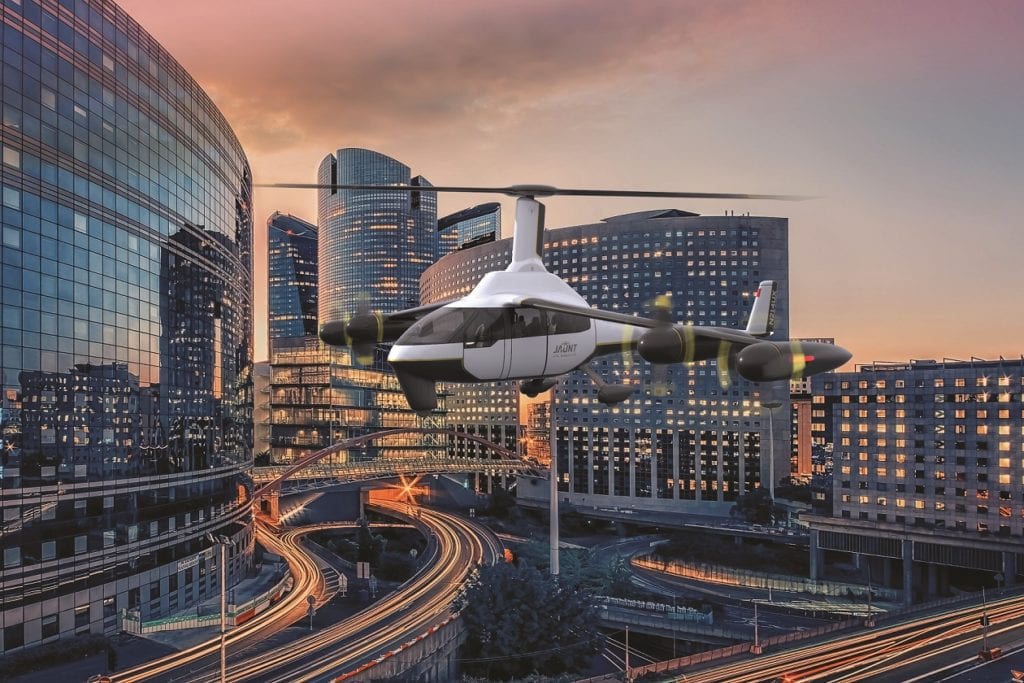
Jaunt Air Mobility is planning to have a fully electric vertical take-off and landing (eVTOL) aircraft in production by 2026. (Jaunt Air Mobility)
Jaunt Air Mobility is planning to have a electric vertical take-off and landing (eVTOL) aircraft in full rate production by 2026, but between now and then they will have to forge a path toward achieving type certification, using a blend of new and existing regulatory guidance.
Jaunt is one of Uber Elevate’s vehicle development partners, currently designing an air taxi that the company describes as resembling a cross between a helicopter and fixed-wing aircraft. Martin Peryea, CEO/CTO of Jaunt Air Mobility, believes certification will be achieved by adhering to early safety assessments and SAE International aerospace recommended practices (ARP), robust and semi-automated software design assurance processes, and separation and partitioning of software systems.
Jaunt Air Mobility’s Journey air taxi will be certified with existing rotorcraft Federal Aviation Administration (FAA) Advisory Circular (AC) 29.1309-2, according to comments made by Peryea during a webinar hosted by Avionics International on Tuesday.
“It boils down to looking at the probability of failure and as you know the public acceptance of airplane fatalities is on a different level compared to typical automobile accidents,” Peryea said. “So, the design of, you know, these types of aircraft really need to be on par with public expectations in terms of safety reliability. So that 10-9 number is something that we’re striving for in our particular system.”

Jaunt Air Mobility’s Journey air taxi. (Jaunt Air Mobility)
The early implementation of two ARP guidelines will help to avoid costly redesign, Peryea said. Development of Journey will follow guidelines for the development of civil aircraft and systems, ARP 4754, and guidelines and methods for conduction the safety assessment process, ARP 4761. ARP 4754 will identify critical functions while ARP 4761 will identify where the aircraft will require redundancy for safety precautions.
“The takeaway here is that you really have to start this process at the very early stages of any aircraft development program,” Peryea said. “A lot of people think they can start sketching out an aircraft design with various types and configurations and unfortunately they don’t fully understand the certification requirements in terms of what’s required to go through that rigorous process to ensure that you address these various failure modes, especially in the catastrophic and hazardous failure modes.”
Under the ARP 4761 development process, safety critical avionics systems hardware and software are developed beginning with the basic aircraft level requirements, allocation of basic functions to systems and the subsequent development of system architecture. Final implementation includes full aircraft systems level implementation, as Peryea explained.
At each step, a key assurance to achieving certification once the designer is ready for regulators occurs by analyzing failure conditions prior to proceeding.

Peryea showed a projected certification timeline for their air taxi during the webinar. (Jaunt Air Mobility)
Peryea believes it is also critical to develop a semi-automated software design assurance processes. Using automation in design assurance can help speed up the development and management of the schedule and associated costs.
“It’s more than just the flight control computers and the avionics, but it also applies to the actuation systems, the motors, motor controllers, and batteries and will require the highest design assurance level (DAL), A and B, for these types of systems,” Peryea said. “And I always like to say the process really drives the design of the aircraft, not the desire of senior management.”
When running software systems for at varying DAL levels, the key to safe aircraft functionality is separation of the systems so that they do not impact each other, Peryea said.
“When trying to run various software systems on the same flight control computers, you really need separation or partitioning of the sessions so that your level C software doesn’t impact your, level A software on these particular types of systems,” Peryea said.